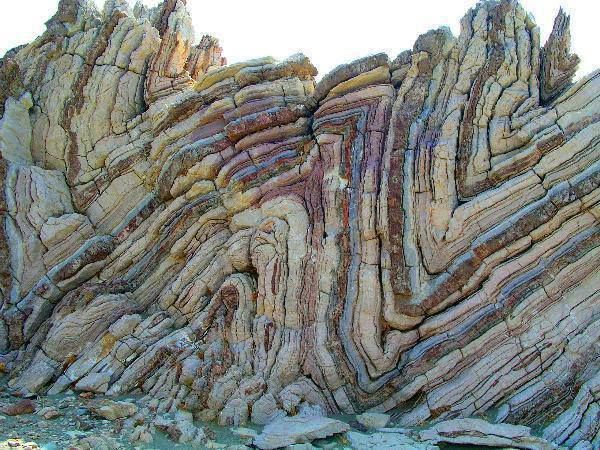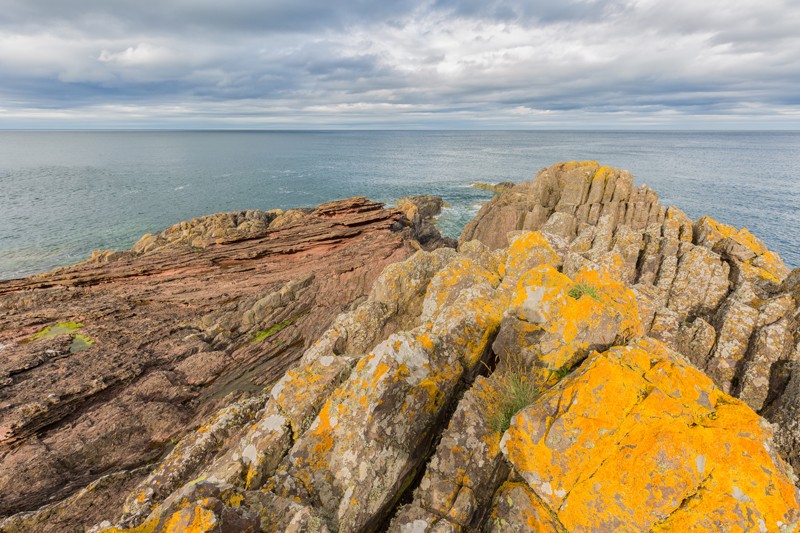A whirlwind geological journey in which the past meets the present and the future.
 The folds of the rocks, Central Crete. Folding is one of the most common geologic phenomena in the world. In geology, deformation is an alteration of the size or shape of rocks. Deformation is caused by stress, the scientific term for force applied to a certain area. Stresses on rocks can stem from various sources, such as changes in temperature or moisture, shifts in the Earth’s plates, sediment buildup or even gravity.
The folds of the rocks, Central Crete. Folding is one of the most common geologic phenomena in the world. In geology, deformation is an alteration of the size or shape of rocks. Deformation is caused by stress, the scientific term for force applied to a certain area. Stresses on rocks can stem from various sources, such as changes in temperature or moisture, shifts in the Earth’s plates, sediment buildup or even gravity.
Crete has some of the world’s oldest known rocks.
Notes from Deep Time: A Journey Through Our Past and Future Worlds
by Helen Gordon (Profile Books, 2021)
27 March 2021 – If there were ever a good time to think about deep time, it’s now. The COVID‑19 pandemic has unmoored us from the rhythms of the “Before Times” and left us scrambling for temporal perspective as the days blur. In such a situation, geology offers a mental anchor – the knowledge that rocks represent untold eons during which animals, plants and even viruses arose, evolved and died.
From my home in Crete, along the glistening Mediterranean sea and shoreline, I can see rock formations that have been dated to the Cambrian period, which is the earliest period in the Palaeozoic era, also known as the Age of Ancient Life. The Cambrian period was an age of great change, spanning approximately 55 million years, during which a great deal of evolution occurred, in both animals and the world’s geography. But at its heart, Crete’s geology is a body of green schist, pale phyllite and yellowing marlstone. These differing bedrocks mean that Crete is rich in minerals, which encourages a variety in flora and fauna to flourish in different regions across the island.
It’s a long story that involves the great plates of Earth’s crust shoved beneath one another in what is now Europe, melting rocks into magma that ferried elements towards the surface. The trials of these rocks – heat, pressure, violence – put the events of the past year into broad context.
So do many other locations venerated for their contributions to geological knowledge. Take Siccar Point, a cliff in southeastern Scotland where eighteenth-century geologist James Hutton saw two rock types jammed against one another — and recognized that they represented enormously different time periods, and that long, uniform processes must have shaped Earth.
“Hutton’s Unconformity”, where two rocks of different ages meet at Siccar Point, Scotland
Or consider the fossil-rich cliffs of Lyme Regis, on England’s south coast, where the mineralized bodies of ammonites and other long-vanished creatures collected by fossil hunters such as Mary Anning in the nineteenth century forced us to take the long view.
In Notes from Deep Time, writer Helen Gordon explores many of these celebrated spots. Facing big changes in her personal life, she sets out to ground herself in the story of landscapes across Europe and North America. The result is a whirlwind tour of our planet’s deep past and far future.
Geology, she shows, offers an odyssey through unfathomable amounts of time. Touch a fragment of an ancient meteorite, and you’re feeling metal that coalesced around the newborn Sun more than 4.5 billion years ago. Visit Canada’s Northwest Territories, and you can hike on a chunk of Earth’s ancient crust dating back four billion years.
Time capsules
That’s the deep-time perspective Gordon craves. And she crams a lot in. In Copenhagen, she visits a repository of ice cores, precious frozen columns that have been carefully drilled from ice sheets in Greenland and elsewhere. They are time capsules containing bubbles of prehistoric air and layers of pollutants such as lead — from which scientists can deduce the amounts of carbon dioxide in the atmosphere in the past, and unravel the history of metal-smelting going back to the ancient Greeks.
Elsewhere, Gordon explores the urban geology of London and Naples, Italy, where the marbles, limestones and granites that make up major buildings are a portal to many past worlds. (As well as to other parts of our current one: the bust of former South African president Nelson Mandela on London’s South Bank sits on a two-billion-year-old piece of igneous rock, a shimmering black stone originally found near Pretoria.)
Gordon wraps in the fan favorites: eruptions, dinosaurs and earthquakes. A visit to the volcano Campi Flegrei, near Naples, is less a meditation on deep time and more an analysis of how scientists monitor active volcanoes and work with local officials to try to keep the fire-mountains from killing anyone. A trip to Utah lumps a visit to a famed bone bed with ruminations on the sale of fossils, and dinosaurs’ enduring appeal to children. And a drive around southern California with seismologists explores questions of just how long we need to study a geological fault, such as the San Andreas, before we can forecast its behavior.
It’s hard not to compare this collage of jaunts with accounts such as Marcia Bjornerud’s 2018 book Timefulness, which synthesizes ideas of deep time in a more holistic way. And Gordon does not explore insights from non-Western cultures, such as Aboriginal Australians’ perspectives on deep time and — apart from one or two nods — the many palaeontological and geological discoveries coming out of China, India and other places across Asia.
Ultimately, however, she succeeds in grounding our existence firmly in the context of geological time. This is especially apparent in the ongoing debate about whether humanity has entered a new geological epoch, the Anthropocene.
Clearly, Homo sapiens has altered the planet. But how and when did this become blindingly obvious? Was it the slow adoption of agriculture some 10,000 years ago? The rise of industrialism in the late eighteenth century? The past century’s acceleration of fossil-fuel burning? The imprint of nuclear-bomb fallout in the world’s sediments, starting with the terrible dawn of the Trinity test in 1945? Scientists debate this in extraordinary detail, as if the particulars of how we affect the planet are less important than the fact that we do.
Looking to the future, Gordon skips past the planet’s imminent climate reckoning, and instead visits the planned nuclear-waste repository in Olkiluoto, Finland. It is meant to hold radioactive debris from nuclear-power plants safely for 100,000 years — the ultimate geological disposal. Deep-time rocks can at least help to isolate humanity’s biggest messes.
